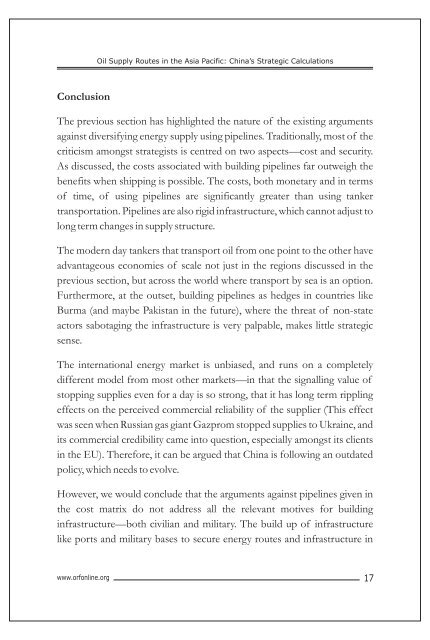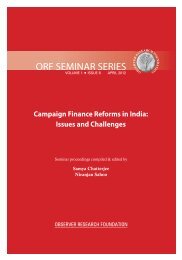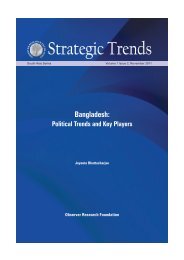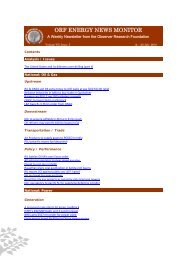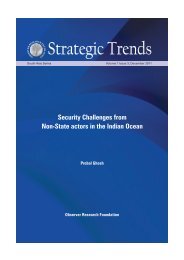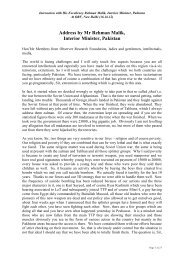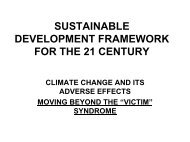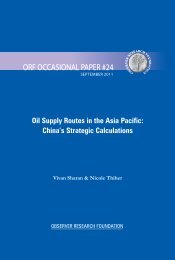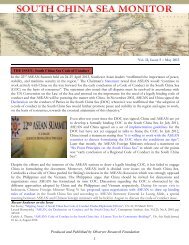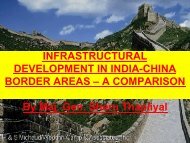Oil Supply Routes in the Asia Pacific: China's Strategic Calculations
Oil Supply Routes in the Asia Pacific: China's Strategic Calculations
Oil Supply Routes in the Asia Pacific: China's Strategic Calculations
Create successful ePaper yourself
Turn your PDF publications into a flip-book with our unique Google optimized e-Paper software.
<strong>Oil</strong> <strong>Supply</strong> <strong>Routes</strong> <strong>in</strong> <strong>the</strong> <strong>Asia</strong> <strong>Pacific</strong>: Ch<strong>in</strong>a’s <strong>Strategic</strong> <strong>Calculations</strong><br />
Conclusion<br />
The previous section has highlighted <strong>the</strong> nature of <strong>the</strong> exist<strong>in</strong>g arguments<br />
aga<strong>in</strong>st diversify<strong>in</strong>g energy supply us<strong>in</strong>g pipel<strong>in</strong>es. Traditionally, most of <strong>the</strong><br />
criticism amongst strategists is centred on two aspects—cost and security.<br />
As discussed, <strong>the</strong> costs associated with build<strong>in</strong>g pipel<strong>in</strong>es far outweigh <strong>the</strong><br />
benefits when shipp<strong>in</strong>g is possible. The costs, both monetary and <strong>in</strong> terms<br />
of time, of us<strong>in</strong>g pipel<strong>in</strong>es are significantly greater than us<strong>in</strong>g tanker<br />
transportation. Pipel<strong>in</strong>es are also rigid <strong>in</strong>frastructure, which cannot adjust to<br />
long term changes <strong>in</strong> supply structure.<br />
The modern day tankers that transport oil from one po<strong>in</strong>t to <strong>the</strong> o<strong>the</strong>r have<br />
advantageous economies of scale not just <strong>in</strong> <strong>the</strong> regions discussed <strong>in</strong> <strong>the</strong><br />
previous section, but across <strong>the</strong> world where transport by sea is an option.<br />
Fur<strong>the</strong>rmore, at <strong>the</strong> outset, build<strong>in</strong>g pipel<strong>in</strong>es as hedges <strong>in</strong> countries like<br />
Burma (and maybe Pakistan <strong>in</strong> <strong>the</strong> future), where <strong>the</strong> threat of non-state<br />
actors sabotag<strong>in</strong>g <strong>the</strong> <strong>in</strong>frastructure is very palpable, makes little strategic<br />
sense.<br />
The <strong>in</strong>ternational energy market is unbiased, and runs on a completely<br />
different model from most o<strong>the</strong>r markets—<strong>in</strong> that <strong>the</strong> signall<strong>in</strong>g value of<br />
stopp<strong>in</strong>g supplies even for a day is so strong, that it has long term rippl<strong>in</strong>g<br />
effects on <strong>the</strong> perceived commercial reliability of <strong>the</strong> supplier (This effect<br />
was seen when Russian gas giant Gazprom stopped supplies to Ukra<strong>in</strong>e, and<br />
its commercial credibility came <strong>in</strong>to question, especially amongst its clients<br />
<strong>in</strong> <strong>the</strong> EU). Therefore, it can be argued that Ch<strong>in</strong>a is follow<strong>in</strong>g an outdated<br />
policy, which needs to evolve.<br />
However, we would conclude that <strong>the</strong> arguments aga<strong>in</strong>st pipel<strong>in</strong>es given <strong>in</strong><br />
<strong>the</strong> cost matrix do not address all <strong>the</strong> relevant motives for build<strong>in</strong>g<br />
<strong>in</strong>frastructure—both civilian and military. The build up of <strong>in</strong>frastructure<br />
like ports and military bases to secure energy routes and <strong>in</strong>frastructure <strong>in</strong><br />
www.orfonl<strong>in</strong>e.org 17


